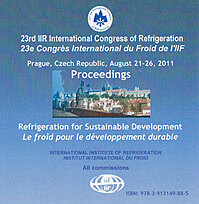
Document IIF
Nouvelle génération d'entrepôts frigorifiques pour l'entreposage des carottes.
Cold store of new generation for carrots storage.
Numéro : pap. ID: 829
Auteurs : MIZERA G., BURTYMOWICZ D.
Résumé
The paper presents the new generation of vegetable cold-storage equipped with the indirect refrigeration system and using the air coolers with the capacity regulation. In place of traditional on/off thermostat (located in the inlet air to the air cooler), the analogue thermostat (with capacity regulation) is applied in the outlet air from air cooler. The control system is based on the three-ways valve with the motor controlled by the analogue thermostat. The applied control system keeps the coolant temperature at the level which is required for the unsteady heat load of the air-cooler. The cold store has capacity of 10 000 tons of carrots and is used for a long-time storage. This cold-storage fulfils the requirements of the modern refrigeration technology: reduction of the refrigerant charge in the system, condensation heat recovery to defrost the aircooler and to heat the social-rooms, plastic piping, application of computerised system for control and supervising, and unification of the applied technical solutions. The technological benefits in terms of quality of stored carrots due to applied capacity regulation approach have been also discussed in the paper.
Documents disponibles
Format PDF
Pages : 6 p.
Disponible
Prix public
20 €
Prix membre*
Gratuit
* meilleur tarif applicable selon le type d'adhésion (voir le détail des avantages des adhésions individuelles et collectives)
Détails
- Titre original : Cold store of new generation for carrots storage.
- Identifiant de la fiche : 30001820
- Langues : Anglais
- Source : Proceedings of the 23rd IIR International Congress of Refrigeration: Prague, Czech Republic, August 21-26, 2011. Overarching theme: Refrigeration for Sustainable Development.
- Date d'édition : 21/08/2011
Liens
Voir d'autres communications du même compte rendu (569)
Voir le compte rendu de la conférence
Indexation
-
Thèmes :
Entrepôts frigorifiques : conception, construction, isolation et équipement;
Entrepôts frigorifiques : fonctionnement, régulation et sécurité;
Entrepôts frigorifiques spécialisés;
Systèmes frigorifiques indirects;
Légumes;
Efficacité energétique, économie d'énergie - Mots-clés : Carotte; Qualité; Entrepôt frigorifique; Entreposage frigorifique; Économie d'energie; Contrôle
-
Cold storage, a flexibility and energy efficien...
- Auteurs : QUARO B.
- Date : 07/04/2016
- Langues : Anglais
- Source : 4th IIR International Conference on Sustainability and the Cold Chain. Proceedings: Auckland, New Zealand, April 7-9, 2016.
- Formats : PDF
Voir la fiche
-
Ductless air-conditioning system using a coanda...
- Auteurs : YOKOI M., SHIBUYA D.
- Date : 16/08/2015
- Langues : Anglais
- Source : Proceedings of the 24th IIR International Congress of Refrigeration: Yokohama, Japan, August 16-22, 2015.
- Formats : PDF
Voir la fiche
-
Optimization of a cooling system of a large-siz...
- Date : 11/11/2020
- Langues : Anglais
- Source : X Congreso Ibérico y VIII Congreso Iberoamericano de Ciencias y Técnicas del Frío, CYTEF 2020.
- Formats : PDF
Voir la fiche
-
Project: De Jong cold stores (The Netherlands).
- Auteurs : MEIJS P.
- Date : 05/02/2007
- Langues : Anglais
- Source : 10th IARW/WFLO European Cold Chain Education Program. Presentations [CD-ROM].
Voir la fiche
-
Project: Sea Invest Antwerp (Belgium).
- Auteurs : MEIJS P.
- Date : 05/02/2007
- Langues : Anglais
- Source : 10th IARW/WFLO European Cold Chain Education Program. Presentations [CD-ROM].
Voir la fiche
